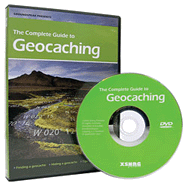 High-Tech Treasure Hunt
High-Tech Treasure Hunt
What is geocaching and what is a geocache?
The word geocache [GEE-oh-cash] comes from two words. The first is the prefix geo, meaning "Earth". The second is cache which is a safe place for hiding or storing something. It can also be the thing which is hidden. For example, the batch of nuts that a squirrel hides for winter is her cache. Your computer keeps the Internet files you are using in a cache.
So a geocache is something that is hidden somewhere on Earth! It is a new word created for the hobby geocaching. People gather up a few little odds and ends and put them in a watertight container. Then they hide it outdoors somewhere, record the coordinates using their GPS receiver, and post the coordinates on the Web.
What is a GPS receiver?
 The initials GPS stand for "global positioning system". The GPS uses a series of 24 satellites that orbit Earth, several ground stations, and GPS receivers which you can carry. When you stand outdoors with your receiver turned on, it will receive radio signals from four (or so) of the satellites which are flying about two miles overhead. By receiving signals from these satellites, the GPS receiver is able to calculate your location on the planet using longitude and latitude coordinates. Coordinates look like this: N 47° 41.026 W 122° 11.038.
The initials GPS stand for "global positioning system". The GPS uses a series of 24 satellites that orbit Earth, several ground stations, and GPS receivers which you can carry. When you stand outdoors with your receiver turned on, it will receive radio signals from four (or so) of the satellites which are flying about two miles overhead. By receiving signals from these satellites, the GPS receiver is able to calculate your location on the planet using longitude and latitude coordinates. Coordinates look like this: N 47° 41.026 W 122° 11.038.
What's the story behind "geocaching"?
The first geocache was hidden on May 3, 2000 by Dave Ulmer in the Portland, Oregon area. Jeremy Irish and Mike Teague were instrumental in bringing the hobby to life, via the Web. Jeremy is the founder and operator of geocaching.com, which is the clearing house for most of the geocaching community. You can read more about its history at that site.
Where are the geocaches?
Geocaches are hidden all over. Later, when you go to the geocaching.com web site, you'll be able to find geocaches in your area. There are thousands of them all over the world! Usually, they are hidden on public land or on private land with the permission of the land owner. The geocaches are hidden well enough that people who aren't looking for them usually don't happen to find them. Some geocaches are easier to get to than others. The watertight containers are usually a cubic foot or smaller.
Who put the geocache there?
Geocaches are hidden by other geocachers. They get the container and the first few items to put inside. They choose the hiding place and record the coordinates, which are then posted on the geocaching.com web site. Hiding a geocache usually means that you have to check on it once in awhile to make sure it is still there and intact. After you have tried geocaching, you and your family may want to make one yourselves!
What is in a geocache?
A geocache can have all sorts of things in it. Generally, there are small items of little value. When you go geocaching, you take items to trade with the geocache. For example, you might find a geocache that has a CD, a toy car, trading cards, and other stuff. You might choose to take the car and leave a kazoo. The general rule is, if you take an item, you leave an item. Most geocaches also have a log book where you record the date and your name (or code name--most geocachers have a code name just for fun). Some geocaches even have a camera so that you can snap a picture of yourself. Never take the camera.
 How do I get started?
How do I get started?
You'll need a GPS receiver, which you can find at many sporting goods stores—or order one online. You might also find The Complete Guide to Geocacaching DVD useful. An excerpt of it apears in the exhibit. The information on this page is from geocachingkids.com and was used with permission. You may get more information there that will get you started on a geocaching hunt. The 'official' site of geocaching is Geocaching.com and that is where you will get the coordinates to a geocache near you!